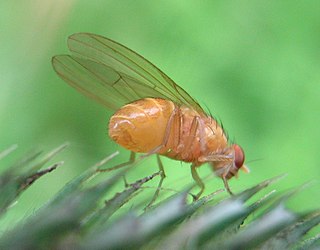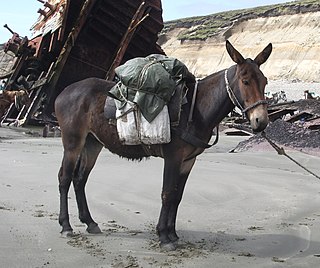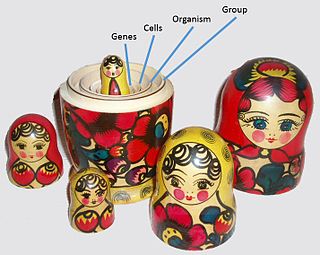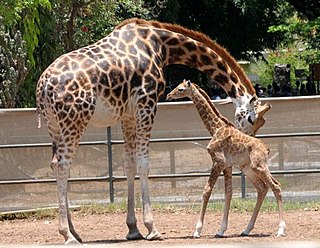Biological specificity is the tendency of a characteristic such as a behavior or a biochemical variation to occur in a particular species.
Biochemist Linus Pauling stated that "Biological specificity is the set of characteristics of living organisms or constituents of living organisms of being special or doing something special. Each animal or plant species is special. It differs in some way from all other species...biological specificity is the major problem about understanding life." [1]
Homo sapiens has many characteristics that show the biological specificity in the form of behavior and morphological traits.
Morphologically, humans have an enlarged cranial capacity[ citation needed ] and more gracile features in comparison to other hominins. The reduction of dentition is a feature that allows for the advantage of adaptability in diet and survival. [2] As a species, humans are culture dependent and much of human survival relies on the culture and social relationships. [3] With the evolutionary change of the reduction of the pelvis and enlarged cranial capacity; events like childbirth are dependent on a safe, social setting to assist in the childbirth; a birthing mother will seek others when going into labor. This is a uniquely human experience, as other animals are able to give birth on their own and often choose to isolate themselves to do so to protect their young. [2] [ citation needed ]
An example of a genetic adaptation unique to humans is the gene apolipoprotein E (APOE4) on chromosome 19. While chimpanzees may have the APOE gene, the study "The apolipoprotein E (APOE) gene appears functionally monomorphic in chimpanzees" shows that the diversity of the APOE gene in humans in unique. [4] The polymorphism in APOE is only in humans as they carry alleles APOE2, APOE3, APOE4; APOE4 which allows human to break down fatty protein and eat more protein than their ancestors is also a genomic risk factor for Alzheimer's disease.
There are many behavioral characteristics that are specific to Homo sapiens in addition to childbirth. Specific and elaborate tool creation and use and language are other areas. Humans do not simply communicate; language is essential to their survival and complex culture. This culture must be learned, is variable and highly malleable to fit distinct social parameters. [5] Humans do not simply communicate with a code or general understanding, but adhere to social standards, hierarchies, technologies, complex system of regulations and must maintain many dimensions of relationships in order to survive. [5] This complexity of language and the dependence on culture is uniquely human.
Intraspecific behaviors and variations exist within Homo sapiens which adds to the complexity of culture and language. Intraspecific variations are differences in behavior or biology within a species. These variations and the complexity within our society lead to social constructs such as race, gender, and roles. These add to power dynamics and hierarchies within the already multifaceted society.
Characteristics may further be described as being interspecific, intraspecific, and conspecific.
Interspecificity (literally between/among species), or being interspecific, describes issues between individuals of separate species. These may include:
Intraspecificity (literally within species), or being intraspecific, describes behaviors, biochemical variations and other issues within individuals of a single species. These may include:
Two or more individual organisms, populations, or taxa are conspecific if they belong to the same species. [8] Where different species can interbreed and their gametes compete, the conspecific gametes take precedence over heterospecific gametes. This is known as conspecific sperm precedence, or conspecific pollen precedence in plants.
The antonym of conspecificity is the term heterospecificity: two individuals are heterospecific if they are considered to belong to different biological species. [9]

Biology – The natural science that studies life. Areas of focus include structure, function, growth, origin, evolution, distribution, and taxonomy.

Mendelian inheritance is a type of biological inheritance following the principles originally proposed by Gregor Mendel in 1865 and 1866, re-discovered in 1900 by Hugo de Vries and Carl Correns, and later popularized by William Bateson. These principles were initially controversial. When Mendel's theories were integrated with the Boveri–Sutton chromosome theory of inheritance by Thomas Hunt Morgan in 1915, they became the core of classical genetics. Ronald Fisher combined these ideas with the theory of natural selection in his 1930 book The Genetical Theory of Natural Selection, putting evolution onto a mathematical footing and forming the basis for population genetics within the modern evolutionary synthesis.

In biology, a hybrid is the offspring resulting from combining the qualities of two organisms of different varieties, species or genera through sexual reproduction. Generally, it means that each cell has genetic material from two different organisms, whereas an individual where some cells are derived from a different organism is called a chimera. Hybrids are not always intermediates between their parents, but can show hybrid vigor, sometimes growing larger or taller than either parent. The concept of a hybrid is interpreted differently in animal and plant breeding, where there is interest in the individual parentage. In genetics, attention is focused on the numbers of chromosomes. In taxonomy, a key question is how closely related the parent species are.
The molecular clock is a figurative term for a technique that uses the mutation rate of biomolecules to deduce the time in prehistory when two or more life forms diverged. The biomolecular data used for such calculations are usually nucleotide sequences for DNA, RNA, or amino acid sequences for proteins. The benchmarks for determining the mutation rate are often fossil or archaeological dates. The molecular clock was first tested in 1962 on the hemoglobin protein variants of various animals, and is commonly used in molecular evolution to estimate times of speciation or radiation. It is sometimes called a gene clock or an evolutionary clock.

A unit of selection is a biological entity within the hierarchy of biological organization that is subject to natural selection. There is debate among evolutionary biologists about the extent to which evolution has been shaped by selective pressures acting at these different levels.

In evolutionary developmental biology, heterochrony is any genetically controlled difference in the timing, rate, or duration of a developmental process in an organism compared to its ancestors or other organisms. This leads to changes in the size, shape, characteristics and even presence of certain organs and features. It is contrasted with heterotopy, a change in spatial positioning of some process in the embryo, which can also create morphological innovation. Heterochrony can be divided into intraspecific heterochrony, variation within a species, and interspecific heterochrony, phylogenetic variation, i.e. variation of a descendant species with respect to an ancestral species.
Paleogenetics is the study of the past through the examination of preserved genetic material from the remains of ancient organisms. Emile Zuckerkandl and Linus Pauling introduced the term in 1963, long before the sequencing of DNA, in reference to the possible reconstruction of the corresponding polypeptide sequences of past organisms. The first sequence of ancient DNA, isolated from a museum specimen of the extinct quagga, was published in 1984 by a team led by Allan Wilson.

Alloparenting is a term used to classify any form of parental care provided by an individual towards young that are not its own direct offspring. These are often referred to as "non-descendant" young, even though grandchildren can be among them. Among humans, alloparenting is often performed by a child's grandparents and older siblings. Individuals providing this care are referred to using the neutral term of alloparent.
The mechanisms of reproductive isolation are a collection of evolutionary mechanisms, behaviors and physiological processes critical for speciation. They prevent members of different species from producing offspring, or ensure that any offspring are sterile. These barriers maintain the integrity of a species by reducing gene flow between related species.
Animal culture can be defined as the ability of non-human animals to learn and transmit behaviors through processes of social or cultural learning. Culture is increasingly seen as a process, involving the social transmittance of behavior among peers and between generations. It can involve the transmission of novel behaviors or regional variations that are independent of genetic or ecological factors.
In the study of the biological sciences, biocommunication is any specific type of communication within (intraspecific) or between (interspecific) species of plants, animals, fungi, protozoa and microorganisms. Communication basically means sign-mediated interactions following three levels of rules. Signs in most cases are chemical molecules (semiochemicals), but also tactile, or as in animals also visual and auditive. Biocommunication of animals may include vocalizations, or pheromone production, chemical signals between plants and animals, and chemically mediated communication between plants and within plants.

There is much to be discovered about the evolution of the brain and the principles that govern it. While much has been discovered, not everything currently known is well understood. The evolution of the brain has appeared to exhibit diverging adaptations within taxonomic classes such as Mammalia and more vastly diverse adaptations across other taxonomic classes. Brain to body size scales allometrically. This means as body size changes, so do other physiological, anatomical, and biochemical constructs connecting the brain to the body. Small bodied mammals have relatively large brains compared to their bodies whereas large mammals have a smaller brain to body ratios. If brain weight is plotted against body weight for primates, the regression line of the sample points can indicate the brain power of a primate species. Lemurs for example fall below this line which means that for a primate of equivalent size, we would expect a larger brain size. Humans lie well above the line indicating that humans are more encephalized than lemurs. In fact, humans are more encephalized compared to all other primates. This means that human brains have exhibited a larger evolutionary increase in its complexity relative to its size. Some of these evolutionary changes have been found to be linked to multiple genetic factors such as, proteins and other organelles.
Dr. Michael Terrence McGuire was an American psychiatrist who made contributions to the theory of psychoanalysis, biological psychiatry, evolutionary biology, sociobiology and the theory and practice of psychiatry.
Self-domestication is the process of adaptation of for example wild animals to cohabiting with humans, without direct human selective breeding of the animals. Dogs and cats have undergone this kind of self-domestication. Self-domestication also refers to the evolution of hominids, particularly humans and bonobos, toward collaborative, docile behavior. As described by British biological anthropologist Richard Wrangham, self-domestication involves being in an environment that favors reduction in aggression, including interspecific and intraspecific antagonism, for survival. The human self-domestication hypothesis argues that, like mammalian domesticates, humans have gone through a process of selection against aggression – a process that in the case of humans was self-induced, in favor of social behavior from which the group as a whole benefited, such as intelligence, soft skills, emotional intelligence and where individuals with an antisocial personality disorder would be eliminated by the group. For this to happen, sophisticated language was necessary to plot against the bully or individual with excessive aggressive behavior, so one would not be killed themselves. It is hypothesized that this is what differentiated Homo erectus and Homo neanderthalensis from H. sapiens: the ability of sophisticated language, allowing better social collaboration, elimination of excessive aggressive behavior in the group, leading to self-domestication and could explain why only homo sapiens survived from all the hominae. Spandrels, or evolutionary byproducts, also accompany self-domestication, including depigmentation, arrested development, and reduced sexual dimorphism.
Human ethology is the study of human behavior. Ethology as a discipline is generally thought of as a sub-category of biology, though psychological theories have been developed based on ethological ideas. The bridging between biological sciences and social sciences creates an understanding of human ethology. The International Society for Human Ethology is dedicated to advancing the study and understanding of human ethology.

The following outline is provided as an overview of and topical guide to evolution:
This glossary of evolutionary biology is a list of definitions of terms and concepts used in the study of evolutionary biology, population biology, speciation, and phylogenetics, as well as sub-disciplines and related fields. For additional terms from related glossaries, see Glossary of genetics, Glossary of ecology, and Glossary of biology.

Allonemobius fasciatus, commonly known as the striped ground cricket, is an omnivorous species of cricket that belongs to the subfamily Nemobiinae. A. fasciatus is studied in depth in evolutionary biology because of the species's ability to hybridize with another Allonemobius species, A. socius.
Reproductive interference is the interaction between individuals of different species during mate acquisition that leads to a reduction of fitness in one or more of the individuals involved. The interactions occur when individuals make mistakes or are unable to recognise their own species, labelled as ‘incomplete species recognition'. Reproductive interference has been found within a variety of taxa, including insects, mammals, birds, amphibians, marine organisms, and plants.
Chemosensory speciation is the evolution of a population to become distinct species that is driven by chemical stimuli. These chemical signals may create premating or other isolating behavioral barriers that prevent gene flow among subpopulations that eventually lead to two separate species.